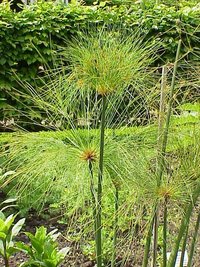Cyperus papyrus
|
|
| Papyrus sedge | ||||||||||||||
|---|---|---|---|---|---|---|---|---|---|---|---|---|---|---|
 Cyperus papyrus | ||||||||||||||
| Scientific classification | ||||||||||||||
|
Papyrus sedge, also known as Bulrush or Paper reed (Cyperus papyrus) is a monocot belonging to the sedge family Cyperaceae. It is a herbaceous perennial native to Africa.
This tall, robust, leafless aquatic can grow 4-5 m high. It features a grass-like clump of triangular green stems that rise up from thick, woody rhizomes. Each stem is topped by a dense cluster of thin, bright green, thread-like rays around 10-30 cm in length. This cluster resembles a feather duster when the plant is young. Greenish-brown flower clusters appear at the ends of the rays. The flowers give way to brown, nut-like fruits.
The younger parts of the rhizome are covered by red-brown, papery, triangular scales, which also cover the base of the culms and represent reduced leaves. It is therefore untrue to call this plant "leafless".
Papyrus is estimated to range from subtropical to tropical desert to wet forests, tolerating annual temperatures of 20-30�C and pH of 6.0 - 8.5. Papyrus flowers in late summer, and prefers full sun to partly-shady conditions. Like most tropical plants, it is sensitive to frost.
The papyrus sedges form vast stands in swamps, shallow lakes, and along stream banks throughout the wetter parts of Africa, but has become rare in the Nile Delta. In deeper waters it is the chief constituent of the floating, tangled masses of vegetation known as sudd. It also occurs also in Madagascar, and some Mediterranean regions such as Sicily and the Levant.
The 'feather-duster' flowering heads make ideal nesting sites for many social species of birds. As in most sedges, pollination is effected by wind, not insects, and the mature fruits after release are distributed by water.
Today, papyrus is mainly cultivated as an aquatic ornamental plant. A dwarf relative of this plant, designated as C. nanus or C. profiler, typically grows to only 1 m tall.
Papyrus in history
- See also the main article Papyrus.
Ancient Egyptians used the plant for many purposes, most famously for making papyrus paper. Its name in Greek and in English is widely believed to have come from Egyptian, but this is likely a folk etymology. Cyperus papyrus is now used mainly for decoration, as it is nearly extinct in its native habitat in the Nile Delta, where in ancient times it was widely cultivated. Theophrastus' "History of Plants" (Book iv. 10) states that it grew in Syria; and, according to Pliny, it was also a native plant of the Niger River and the Euphrates.
Aside from papyrus, several other members of the genus Cyperus may actually have been involved in the multiple uses Egyptians found for the plant. Its flowering heads were linked to make garlands for the gods in gratitude. The pith of young shoots was eaten both cooked and raw. Its woody root made bowls and other utensils and was burned for fuel. From the stems were made reed boats (seen in bas-reliefs of the Fourth Dynasty showing men cutting papyrus to build a boat; similar boats are still made in the southern Sudan), sails, mats, cloth, cordage, and sandals. Theophrastus states that King Antigonus made the rigging of his fleet of papyrus, an old practice illustrated by the ship's cable, wherewith the doors were fastened when Odysseus slew the suitors in his hall (Odyssey xxi. 390).
